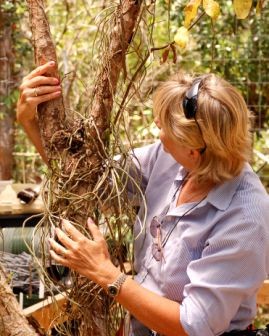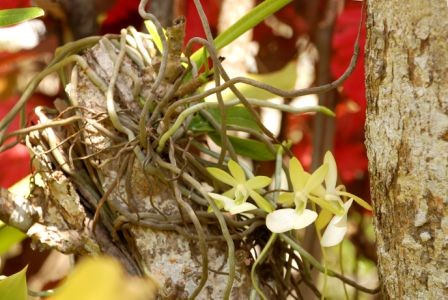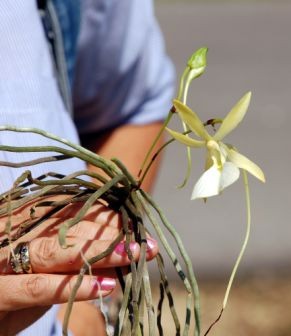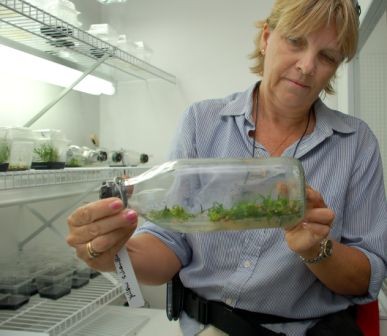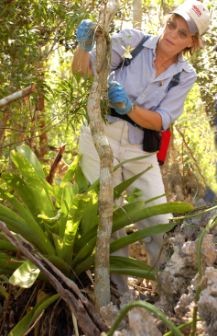How important are indigenous plants to the Cayman Islands? “Very important. Important enough to halt road-works and heavy machinery for weeks,” says National Roads Authority (NRA) Deputy Director of Engineering and Operations, Paul Parchment.
And for the last three weeks, that’s been the situation in a section of George Town woodland, behind the University College of the Cayman Islands. It is also the area through which the Linford Pierson Highway extension is to run.
“Initially, a large roundabout was planned there and that would have forced us to clear an area in which very rare Ghost Orchids (Dendrophaylax fawcettii) found only in Grand Cayman, have since been discovered,” Mr Parchment explained.
The discovery prompted the NRA’s board of directors to have the road re-engineered and redesigned, ensuring that disturbance to the area is now greatly reduced.
“The roundabout has been removed from that section of road and we’ve arched it as far as we possibly can, without compromising safety, making the roadway mostly skirt or border the area,” he continued.
In the meantime, all work has stopped to allow the Orchid Society’s Chairman of Orchid Rescue Sue Gibb and Cayman Nature’s Ann Stafford to hike the area and remove the endangered plants. The orchids have gone to a shade house at the Queen Elizabeth II Botanic Park to await replanting.
“We really appreciate government’s collaboration in rescuing these plants,” Ms Gibb commented. “This is the best way to protect them. We seldom get an opportunity to go in and rescue native flora when developers are clearing land. We hope that this will signal other companies undertaking large projects requiring excavation to work with us.”
Some of the rescued plants are destined to be part of the Botanic Park’s planned orchid garden. The remaining ones will be re-established in the wild (beginning Saturday, 12 April) in areas mimicking their original habitat. Until then the orchids, which do not require soil to survive but instead attach themselves to tree branches, will be tended by Orchid Society members.
Cayman Nature’s Ann Stafford and Orchid Society members have also been busy making arrangements to remove other endemic plants (found only in the Cayman Islands) from the same section of George Town woodland. These include Old George or Hohenbergia (Hohenbergia caymanensis); Ironwood (Chionanthus caymanensis); Wild Banana Orchid (Myrmecophila thomsoniana var. thomsoniana); and Broadleaf (Cordia sebestena var. caymanensis).
“The NRA is totally committed to this environmental protection project,” concluded Mr Parchment. “However long it takes for the plant rescue to finish, we are prepared to wait.”
Sidebar: Endemic to the Caymazn Islands
There are 415 species and varieties of plants believed to be truly native to the Cayman Islands. These are the plants which formed the original, ancient flora of the three islands.
Over the two to three million years between Cayman’s most recent emergence from the sea, and the arrival of humans, 29 species and varieties of plants evolved to local conditions to the point that they are now regarded as unique (endemic) to the Cayman Islands. These are plants which, should they be lost from the Islands, will be lost to the world.
Visit www.caymanbiodiversity.com for more information on Cayman’s endemic plant species.
Source: http://www.caymanbiodiversity.com
Photo captions Photo by Information Officer Kenisha Morgan.
- Ghost Orchid: A Dendrophaylax fawcettii commonly known as the Ghost Orchid.
- Ghost Orchid 2: Ghost Orchids do not require soil for growth. They generally attach themselves to the branches of trees overhanging Hohenbergia caymanensis (commonly known as either Hohenbergia or Old George) plants.
- Removing an Orchid: Orchid Society Chairman of Orchid Rescue Sue Gibb skilfully removes a Ghost Orchid plant overhanging a Hohenbergia caymanensis or Old George plant in a section of the George Town woodland behind Wendy’s on Walkers Road.
- At the Botanic Park: Ghost Orchids (Dendrophaylax fawcettii) under care at the Queen Elizabeth II Botanic Park.
- Hand propagated orchids: Cayman Islands Orchid Society Chairman of Orchid Rescue Sue Gibb shows the saplings of hand-pollinated orchids in the society’s Orchid Propagation Unit at the Botanic Park.
